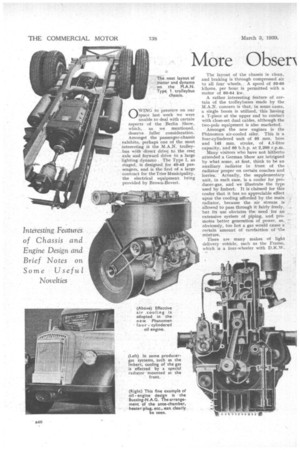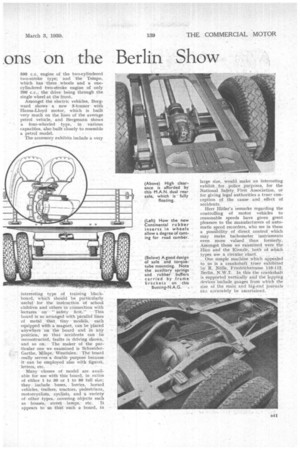More Obsen ons on the Berlin Show
Page 50

Page 51

If you've noticed an error in this article please click here to report it so we can fix it.
WING to pressure on our space last week we were unable to deal with certain aspects of the Berlin Show, which, as we mentioned, deserve fuller consideration. Amongst the passenger-chassis exhibits, perhaps one of the most interesting iS the M.A.N. trolleybus with direct drive to the rear axle and forward drive to a large lighting dynamo The Type I, as staged, is designed for 40-45 passengers, and is the first of a large contract for the Trier Municipality, the electrical equipment being provided by Brown-Boveri.
The layout of the chassis is clean, and braking is through compressed air to all four wheels. A speed of 50-60 kiloms. per hour is permitted with a motor of 60-64 kw.
A rather interesting feature of certain of the trolleybuses made by the M.A.N. concern is that, in some cases, a single boom is utilized, this having a T-piece at the upper end to contact with close-set dual cables, although the two-pole equipment is also marketed.
Amongst the new engines is the Ph&nomen air-cooled oiler. This is a four-cylindered unit of 95 mm. bore and 145 mm. stroke, of 4.1-litre capacity, and 60 b.h.p. at 2,200 r.p.n-1.
Many visitors who have not hitherto attended a German Show are intrigued by what some, at first, think to be an auxiliary radiator in front of the radiator proper on certain coaches and lorries. Actually, the supplementary unit, in each case, is a cooler for producer-gas, and we illustrate the type used by halbert. It is claimed for this cooler that it has no appreciable effect upon the cooling afforded by the main radiator, because the air stream is allowed to pass through it fairly freely, but its use obviates the need for an extensive system of piping, and promotes better generation of power, as, obviously, too hot a gas would cause a certain amount of rarefaction of the mixtare.
There are many makes of light delivery vehicle, such as the Framo, which is a four-wheeler with D.K.W. 500 c.c. engine of the two-tylindered two-stroke type; and the Tempo, which has three wheels and a onecylindered two-stroke engine of only 200 c.c., the drive being through the single wheel at the front.
Amongst the electric vehicles, I3orgward shows a new 3-tonner with Hansa-Lloyd motor, which is built very much on the lines of the average petrol vehicle, and Bergmann shows a four-wheeled type, in various capacities, also built closely to resemble a petrol model.
The accessory exhibits include a very interesting type of training blackboard, which should be particularly useful for the instruction of seliool children and others in canneCtion with lectures on " safety first." This board is so arranged with parallel' lines of metal that tiny • models, each • equipped with a magnet, can be placed anywhere on the board and in any position; so that accidents can be reconstructed, faults in driving shown, and so on. The maker of the par-ticular one we examined is SchneiderGarthe, Milspe, Westfalen. The board really serves a double purpose because it can be employed also with figures, letters, etc. • • Many classes of model are available for use with this board, in ratios of either 1 to 30 or 1 to 60 full size; they include buses, lorries, horsed vehicles, trailers, tractors, pedestrians, motorcyclists, cyclists, and a variety of other types, covering objects such as houses, street lamps, etc. It appears to us that such a board, in large size, would make an interesting exhibit for police purposes, for the National Safety First Association, or for giving legal authorities a truer conception of the cause and effect of accidents.
Herr Hitler's remarks regarding the controlling of motor vehicles to reasonable speeds have given great pleasure to the manufacturers of automatic speed recorders, who see in these a possibility of direct control which may make tachometer instruments even more valued than formerly. Amongst those we examined were the Hico and the Kienzle, both of which_ types use a circular chart.
One simple machine which appealed to us is a crankshaft truer exhibited by R. Nolle, Friedrichstrasse 110-112, Berlin, N.W.7. In this the crankshaft is supported vertically and the lapping devices • include gauges from which the size of the main and big-end jonrnals can accurately be ascertained.




















































































